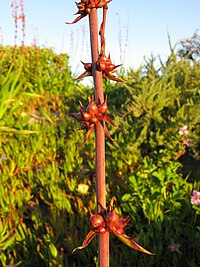
Photo from wikipedia
Human germline-soma segregation occurs during weeks 2-3 in gastrulating embryos. While direct studies are hindered, here we investigate the dynamics of human primordial germ cell (PGCs) specification using in vitro… Click to show full abstract
Human germline-soma segregation occurs during weeks 2-3 in gastrulating embryos. While direct studies are hindered, here we investigate the dynamics of human primordial germ cell (PGCs) specification using in vitro models with temporally resolved single-cell transcriptomics and in-depth characterisation to in vivo datasets from human and non-human primates, including a 3D marmoset reference atlas. We elucidate the molecular signature for the transient gain of competence for germ cell fate during peri-implantation epiblast development. Further, we show that both the PGCs and amnion arise from transcriptionally similar TFAP2A positive progenitors at the posterior end of the embryo. Notably, genetic loss of function experiments show that TFAP2A is crucial for initiating the PGC fate without detectably affecting the amnion, and its subsequently replaced by TFAP2C as an essential component of the genetic network for PGC fate. Accordingly, amniotic cells continue to emerge from the progenitors in the posterior epiblast, but importantly, this is also a source of nascent PGCs.
Journal Title: Life Science Alliance
Year Published: 2022
Link to full text (if available)
Share on Social Media: Sign Up to like & get
recommendations!